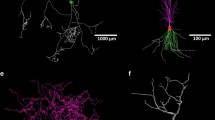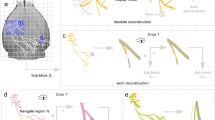Abstract
Neurons are classified into several morphological types according to the locations of their somata and the branching patterns of their axons and dendrites. Recent studies suggest that these morphological features are related to their physiological properties, including firing characteristics, responses to neuromodulators, and wiring patterns. Therefore, rapid morphological identification of electrophysiologically recorded neurons promises to advance our understanding of neuronal circuits. One of the most common anatomical cell identification methods is neuronal reconstruction with biocytin delivered through whole-cell patch-clamp pipettes. However, conventional reconstruction methods usually take longer than 24 h and limit the throughput of electrophysiological experiments. Here, we developed a quick, simple cell reconstruction method by optimizing the tissue clearing protocol ScaleSQ. We found that adding 200 mM NaCl almost entirely prevented tissue swelling without compromising optical clearing ability. This solution, termed IsoScaleSQ, allowed us to increase the transparency of the gray matter of 500-µm-thick slices within 30 min, meaning that the total time required to reconstruct whole-cell recorded neurons was reduced to 1 h. This novel method will improve the efficacy and effectiveness of electrophysiological experiments linked to cell morphology.






Similar content being viewed by others
References
Chen F, Tillberg PW, Boyden ES (2015) Optical imaging. Expansion microscopy. Science 347:543–548
Chung K, Wallace J, Kim SY et al (2013) Structural and molecular interrogation of intact biological systems. Nature 497:332–337
Eguchi M, Yamaguchi S (2009) In vivo and in vitro visualization of gene expression dynamics over extensive areas of the brain. Neuroimage 44:1274–1283
Funayama K, Minamisawa G, Matsumoto N et al (2015) Neocortical rebound depolarization enhances visual perception. PLoS Biol 13:e1002231
Graves AR, Moore SJ, Bloss EB, Mensh BD, Kath WL, Spruston N (2012) Hippocampal pyramidal neurons comprise two distinct cell types that are countermodulated by metabotropic receptors. Neuron 76:776–789
Hama H, Hioki H, Namiki K et al (2015) ScaleS: an optical clearing palette for biological imaging. Nat Neurosci 18:1518–1529
Horikawa K, Armstrong WE (1988) A versatile means of intracellular labeling: injection of biocytin and its detection with avidin conjugates. J Neurosci Methods 25:1–11
Ishikawa D, Matsumoto N, Sakaguchi T, Matsuki N, Ikegaya Y (2014) Operant conditioning of synaptic and spiking activity patterns in single hippocampal neurons. J Neurosci 34:5044–5053
Jiang X, Shen S, Cadwell CR et al (2015) Principles of connectivity among morphologically defined cell types in adult neocortex. Science 350:aac9462
Ke MT, Fujimoto S, Imai T (2013) SeeDB: a simple and morphology-preserving optical clearing agent for neuronal circuit reconstruction. Nat Neurosci 16:1154–1161
Klausberger T, Somogyi P (2008) Neuronal diversity and temporal dynamics: the unity of hippocampal circuit operations. Science 321:53–57
Ku T, Swaney J, Park JY et al (2016) Multiplexed and scalable super-resolution imaging of three-dimensional protein localization in size-adjustable tissues. Nat Biotechnol 34:973–981
Kubota SI, Takahashi K, Nishida J et al (2017) Whole-body profiling of cancer metastasis with single-cell resolution. Cell Rep 20:236–250
Kuga N, Sasaki T, Takahara Y, Matsuki N, Ikegaya Y (2011) Large-scale calcium waves traveling through astrocytic networks in vivo. J Neurosci 31:2607–2614
Larkman A, Mason A (1990) Correlations between morphology and electrophysiology of pyramidal neurons in slices of rat visual cortex. I. Establishment of cell classes. J Neurosci 10:1407–1414
Margrie TW, Brecht M, Sakmann B (2002) In vivo, low-resistance, whole-cell recordings from neurons in the anaesthetized and awake mammalian brain. Pflugers Arch 444:491–498
Markram H, Toledo-Rodriguez M, Wang Y, Gupta A, Silberberg G, Wu C (2004) Interneurons of the neocortical inhibitory system. Nat Rev Neurosci 5:793–807
Mizuseki K, Diba K, Pastalkova E, Buzsaki G (2011) Hippocampal CA1 pyramidal cells form functionally distinct sublayers. Nat Neurosci 14:1174–1181
Neher E (1992) Ion channels for communication between and within cells. Science 256:498–502
Pan C, Cai R, Quacquarelli FP et al (2016) Shrinkage-mediated imaging of entire organs and organisms using uDISCO. Nat Methods 13:859–867
Ricka J, Tanaka T (1984) Swelling of ionic gels: quantitative performance of the Donnan theory. Macromolecules 17:2916–2921
Sakaguchi T, Ishikawa D, Nomura H, Matsuki N, Ikegaya Y (2012) Normal learning ability of mice with a surgically exposed hippocampus. Neuroreport 23:457–461
Susaki EA, Ueda HR (2016) Whole-body and whole-organ clearing and imaging techniques with single-cell resolution: toward organism-level systems biology in mammals. Cell Chem Biol 23:137–157
Yang B, Treweek JB, Kulkarni RP et al (2014) Single-cell phenotyping within transparent intact tissue through whole-body clearing. Cell 158:945–958
Acknowledgements
This work was supported by JST ERATO (JPMJER1801), JSPS Grants-in-Aid for Scientific Research (18H05525), and the Human Frontier Science Program (RGP0019/2016). This work was conducted partly as a program at the International Research Center for Neurointelligence (WPI-IRCN) of The University of Tokyo Institutes for Advanced Study at The University of Tokyo.
Author information
Authors and Affiliations
Corresponding author
Ethics declarations
Conflict of interest
The authors have no conflict of interest to declare
Additional information
Publisher’s Note
Springer Nature remains neutral with regard to jurisdictional claims in published maps and institutional affiliations.
Rights and permissions
About this article
Cite this article
Sato, Y., Miyawaki, T., Ouchi, A. et al. Quick visualization of neurons in brain tissues using an optical clearing technique. Anat Sci Int 94, 199–208 (2019). https://doi.org/10.1007/s12565-018-00473-z
Received:
Accepted:
Published:
Issue Date:
DOI: https://doi.org/10.1007/s12565-018-00473-z




